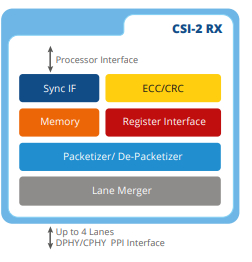Description
The MIPI Camera Serial Interface 2 (CSI-2) is an interface between a Camera and a host processor baseband application engine. This interface is defined by MIPI Alliance, which defines a series of modules in a MIPI compliant product. This MIPI CSI-2 Receiver is used in mobile and high–speed serial applications as a controller for receiving camera video and transmitting camera commands from/to MIPI CSI-2 Transmitter over MIPI lines. The camera data is encoded and then transmitted. The MIPI CSI-2 Transmitter along with our MIPI CSI-2 Receiver and MIPI DPHY provides a complete solution for decoding MIPI CSI-2 data. MIPI CSI2 Receiver is used in mobile and high–speed serial applications where a camera can receive the video data sent to it over MIPI lines from the MIPI CSI2 Transmitter, for decoding the data and use it for subsequent processing. MIPI CSI2 Receiver adheres to MIPI CSI2 Specification.

Features
-
Compliant with MIPI CSI-2 Specification v1.1
-
Complaint with MIPI DPHY V1.1
-
Lane configuration: CSI2_ RX: Programmable 1, 2, or 4 Data Lane Configuration.
-
Operate in continuous and non-continuous clock modes.
-
Supported YUV Data Types : YUV420_8bit, YUV420_10bit, YUV422_8Bit, YUV422_10bit, YUV420_8Bit_CSPS, YUV420_10bit_CSPS, LEGACY YUV420_8bit,
-
Supported RGB Data Types: RGB888, RGB565, RGB666, RGB555, and RGB444.
-
Supported RAW Data Types: RAW6, RAW7, RAW8, RAW10, RAW12, and RAW14.
-
Supports User defined data types.
-
Pixel Interface: 64 bit Pixel data alignment
-
Data Rate: CSI-2 DPHY : Up to 1.5 Gbps per lane
-
Selectable Register configurations through Generic Parallel interface
Deliverables
-
Configurable RTL Code
-
HDL-based test bench and behavioral models
-
Test cases
-
Protocol checkers, bus watchers, and performance monitors
-
Configurable synthesis shell
-
Design guide
-
Verification guide
-
Synthesis guide
Benefits
-
Data lane count
-
Color modes
-
Pixel interface width
-
Application interface –Pixel or AXI
-
Command FIFO depth
-
Highly modular and configurable design
-
Layered architecture
-
Active low async reset
-
Clearly demarcated clock domains
-
Extensive clock gating support
Applications
-
Mobile
-
IOT
-
Automotive
-
Wearables
![]()